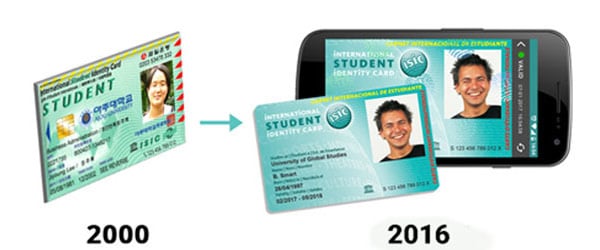Go back in time and learn about the most important milestones of card design with the history of ISIC’s creation.
ISIC has become an integral part of the lives of many students and scholars around the globe these days. With a mission to make life easier for young people through exclusive benefits and advantages, ISIC has established itself as both the only internationally recognized ID card and a flexible lifestyle product. To review the last milestones of the card, here is a short review of more than 65 years of ISIC, where you can follow the development of ISIC in more detail.

The year 1953 marks the birth of ISIC: Freely following the motto of students for students, ISIC was founded as part of an initiative between Norwegian and Dutch students in Copenhagen. With the help of the Danish Coordinating Secretariat of National Student Associations (COSEC), the final launch was successful, although no one would have guessed at the time that some 65 years later this simple idea would develop into a global network with more than 120 million cardholders to date. The very first card resembled an old passport and, in addition to a black-and-white photo, offered all the important information about the person in handwritten form.
The black-and-white design was finally abandoned in 1972 and the decision was made to use colored stamps to set visual accents. It was in the 1970s and 1980s that ISIC really blossomed, forging new partnerships with prestigious airlines and providing students and schoolchildren with new discounted travel opportunities.
It is not without reason that the map has also been supported by UNESCO (United Nations Educational, Scientific and Cultural Organization) since 1968. In fact, due to the same mission, the organization decided to consider the ISIC card as the only recognized student card in the world, which not only enables international exchange between countries, cultures and people, but also promotes the dissolution of intercultural barriers. UNESCO’s support is instrumental to ISIC, so much so that the UNESCO logo has also adorned the ISIC card since 1993.

Before that, however, it said goodbye to the paper format for good in 1989 and switched to plastic cards, which were not only much more robust but also available in more colors. The new design picks up on the classic ISIC turquoise and impresses with a more manageable card format. In addition, technological progress enabled the development of co-brand cards, so that since the early 1990s ISIC cards can also be issued with a logo of cooperation partners.
The card then evolved into a lifestyle product in 2001, culminating in a major relaunch in 2008/2009. Since then, co-brand partners have been given more leeway to create their own individual card design, so the card has become more personalized over the years.

The year 2016 also marks an important milestone in the history of the card with the launch of the app-based virtual ISIC. On the one hand, the virtual ISIC via smartphone enables even more flexible use, as mobile ID can be used anytime and anywhere. On the other hand, the virtual ISIC will gradually replace the plastic card in the future, also for ecological reasons.

This was followed by a complete rebranding of the entire ISIC design in 2019. From logos to company documents, everything was revised. With the new design, ISIC is again increasingly focusing on simplicity as well as clear structures, which not only offer a better overview, but also correspond more to the classic and modern zeitgeist.

Since 2022, the ISIC has been available in a vertical design in the ISIC app, making it even more convenient to display on a smartphone.
We are curious how the journey will continue…